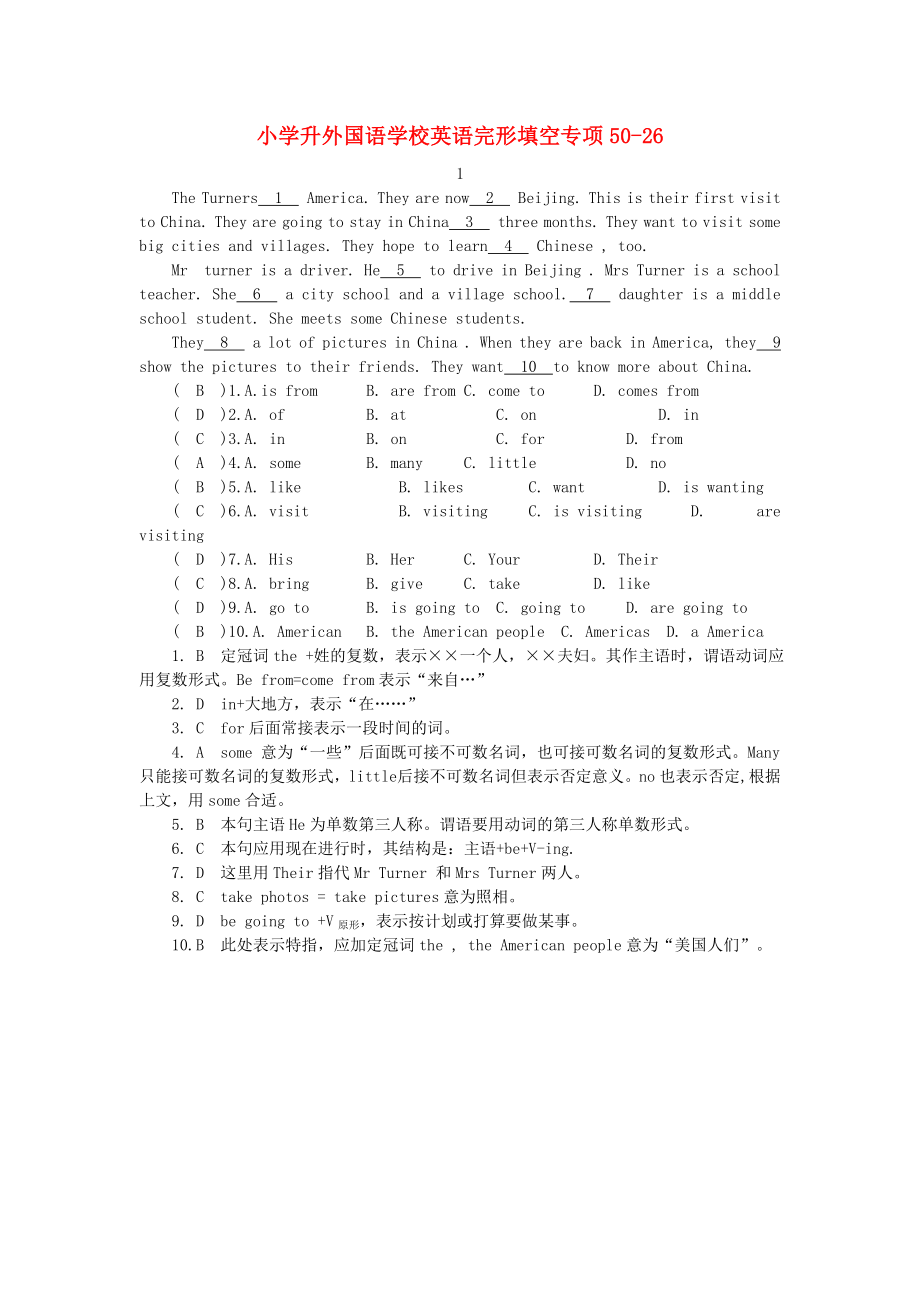《寧夏外國語學(xué)校小升初英語專項(xiàng)訓(xùn)練 完形填空26》由會(huì)員分享����,可在線閱讀,更多相關(guān)《寧夏外國語學(xué)校小升初英語專項(xiàng)訓(xùn)練 完形填空26(2頁珍藏版)》請(qǐng)?jiān)谘b配圖網(wǎng)上搜索����。
1、小學(xué)升外國語學(xué)校英語完形填空專項(xiàng)50-26
1
The Turners 1 America. They are now 2 Beijing. This is their first visit to China. They are going to stay in China 3 three months. They want to visit some big cities and villages. They hope to learn 4 Chinese , too.
Mr turner is a driver. He 5 to drive in B
2��、eijing . Mrs Turner is a school teacher. She 6 a city school and a village school. 7 daughter is a middle school student. She meets some Chinese students.
They 8 a lot of pictures in China . When they are back in America, they 9 show the pictures to their friends. They want 10 to know
3���、 more about China.
( B )1.A.is from B. are from C. come to D. comes from
( D )2.A. of B. at C. on D. in
( C )3.A. in B. on C. for D. from
( A )4.A. some B. many C. little D. no
( B )5.A. like B. likes C. want D. is wanting
( C )6.A. visit B. visiting C. i
4����、s visiting D. are visiting
( D )7.A. His B. Her C. Your D. Their
( C )8.A. bring B. give C. take D. like
( D )9.A. go to B. is going to C. going to D. are going to
( B )10.A. American B. the American people C. Americas D. a America
1. B 定冠詞the +姓的復(fù)數(shù)���,表示××一個(gè)人����,××夫婦���。其作主語時(shí)���,謂語動(dòng)詞
5、應(yīng)用復(fù)數(shù)形式�����。Be from=come from表示“來自…”
2. D in+大地方,表示“在……”
3. C for后面常接表示一段時(shí)間的詞���。
4. A some 意為“一些”后面既可接不可數(shù)名詞�����,也可接可數(shù)名詞的復(fù)數(shù)形式。Many只能接可數(shù)名詞的復(fù)數(shù)形式�����,little 后接不可數(shù)名詞但表示否定意義����。no也表示否定,根據(jù)上文,用some合適�。
5. B 本句主語He為單數(shù)第三人稱。謂語要用動(dòng)詞的第三人稱單數(shù)形式���。
6. C 本句應(yīng)用現(xiàn)在進(jìn)行時(shí)����,其結(jié)構(gòu)是:主語+be+V-ing.
7. D 這里用Their指代Mr Turner 和Mrs Turner兩人。
8.
6�、C take photos = take pictures意為照相。
9. D be going to +V原形�,表示按計(jì)劃或打算要做某事。
10.B 此處表示特指�����,應(yīng)加定冠詞the , the American people意為“美國人們”����。
2
Let’s look at the 1 .The boy’s name is John. There are three people 2 his family. 3 father works in a bank(銀行) and his 4 is a teacher.
7、 She teaches Chinese. He’s 5 in 6 Japanese school. He has many Japanese 7 there. Their class begins 8 eight o’clock. They 9 four lessons in the morning and two lessons in the 10 .
( C )1.A. boy B. dialogue C. picture D. girl
( B )2.A. of B. in C. at D. on
( A )
8���、3.A. His B. Her C. He D. They
( C )4.A. brother B. sister C. mother D. father
( A )5.A. in Grade Two B. in Two grade C. in Grade two D. in grade two
( A )6.A. a B. an C. the D. /
( C )7.A. a friend B. friend C. friends D. the friends
( B )8.A. in B. at C. on
9��、 D. of
( D )9.A. has B. is C. are D. have
( B )10.A. morning B. afternoon C. evening D. noon
1. C 本題主要考查對(duì)全文的理解�。因后面提及的是家庭中的每個(gè)成員��,故可以判定�����,他們要看是一張相片�,故選擇C�����。
2. B “在家庭中”的英文表達(dá)為“in the family”�,故選擇B選項(xiàng)���。
3. A 此處應(yīng)指上文提及的男孩子的爸爸����,故應(yīng)用his���,選擇A選項(xiàng)。
4. C 本題主要考查對(duì)原文上下文的理解�����。文中曾提及在這個(gè)男孩家中有三個(gè)人��,說過了爸爸����,這時(shí)提到的肯
10、定是媽媽��,故選擇C答案。
5. A 本題主要考查“在二年級(jí)”的英文表達(dá)�����,即in Grade Two.主要注意大寫�,故選擇A選項(xiàng)。
6. A 因這里是泛指����,且后面詞是以非元音音素開頭,故選擇A選項(xiàng)����。
7. C 本題主要考查可數(shù)名詞的用法。此處為泛指�����,且前有many修飾����,故應(yīng)用可數(shù)名詞復(fù)數(shù)friends ,即C選項(xiàng)。
8. B 本題主要考查名詞的用法�。在英語中,具體時(shí)間點(diǎn)的前面應(yīng)用介詞at ���,故選擇B選項(xiàng)�����。
9.D 本題主要考查對(duì)句意的理解��。此處意為:他們?cè)谏衔缬兴墓?jié)課��,故應(yīng)用have,即D選項(xiàng)���。
10.B 此處意為: 他們?cè)谏衔缬兴墓?jié)課�,在下午有兩節(jié)課����,故應(yīng)用afternoon,即B選項(xiàng)�����。
 寧夏外國語學(xué)校小升初英語專項(xiàng)訓(xùn)練 完形填空26
寧夏外國語學(xué)校小升初英語專項(xiàng)訓(xùn)練 完形填空26

